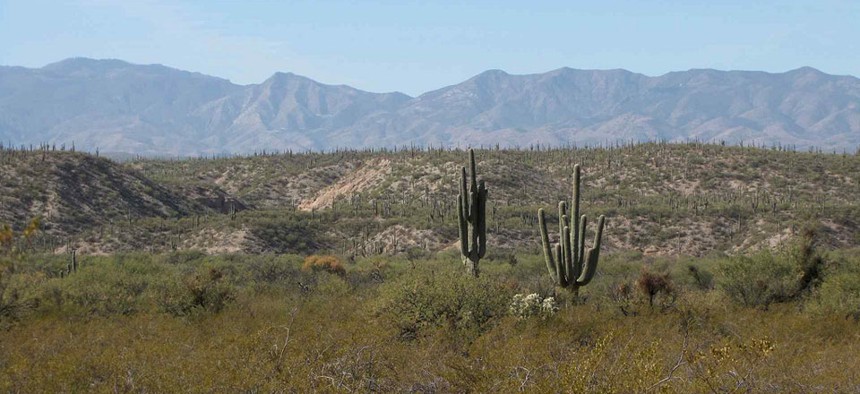Pentagon and Environmentalists Unite in Opposition to Proposed Power Line Route

Flickr user lonqueta
Project threatens operations at White Sands Missile Range and riparian areas in Arizona, critics say.
The Defense Department and environmental groups find themselves facing a common enemy in their strong opposition to a proposed 515 mile high-voltage electric transmission line touted as a way to transmit “green” wind energy from rural New Mexico to urban markets in Arizona and potentially California.
The proposed SunZia system includes two single-circuit, bi-directional 500 kV transmission lines strung from 135-foot towers spaced 1,400 feet apart along the proposed route, which runs from a substation near the small town of Corona, N.M., 82 miles southeast of Albuquerque, to another substation near Eloy, Ariz., roughly halfway between Tuscon and Phoenix.
The Bureau of Land Management, which has overseen the right-of-way process for SunZia since 2009, selected a preferred route for the transmission line on June 14. But Pentagon officials say that route, which crosses the north end of White Sands Missile Range, N.M., jeopardizes operations at the range, thereby threatening national security.
Environmental groups say the preferred route in Arizona, which includes roughly 40 miles through the undeveloped San Pedro River Valley east of Tucson, could cause “degradation to globally significant riparian areas” -- home to 100 species of breeding birds and another 250 species of migratory birds.
Frank Kendall, undersecretary of Defense, said in a March 19 letter to David Hayes, deputy secretary of Interior, that the route proposed by BLM poses “unacceptable risk to national security.” Kendall urged the agency, which is part of the Interior Department, to select a different route when it releases its final environmental impact statement on the SunZia system.
Kendall said BLM’s draft plan, issued in May 2012, would “preclude the capability to fully test the Joint Integrated Air and Missile Defense Architecture and other weapons systems under realistic threat environments at [White Sands].”
“This is due to the vertical obstruction such power lines would pose to low-level missile flight tests. It is possible that a missile could inadvertently strike the power line or catastrophically fail and shower debris on the power line,” Kendall told Hayes.
Army leaders are also unhappy with the proposal. In comments on the proposed route, the service said the towers could interfere with low level flights conducted by the German Air Force Flying Training Center at Holloman Air Force Base in Alamogordo, N.M. The German air force trains Tornado fighter-bomber pilots in New Mexico rather than Europe due to the unrestricted air space at the missile range.
The planned SunZia power line “represents a significant increase in safety hazards to pilots conducting both testing and training missions,” the Army maintains.
If BLM selects a SunZia route through the missile range, then the company should be required to bury the line, Kendall said.
BLM’s preferred alternative for the SunZia line ignored Kendall and the Army. That route crosses the “northern extension area” of White Sands Missile Range -- land leased from ranchers on a “call up” basis to support test and flights.
Katherine Hammack, assistant secretary of the Army for installations, energy and environment, said the service strongly opposes the SunZia route identified in the final impact statement where it enters the restricted airspace and call-up area north of White Sands.
Any vertical structure at the height of transmission lines “negatively impacts the military mission,” Hammack said in a written statement.
“The impact to military mission would be significant and irreversible because we will no longer be able to conduct certain tests. White Sands Missile Range provides unique testing characteristics and capabilities that cannot be duplicated within the United States. The testing the military conducts at WSMR must be performed to ensure functionality of our military defense systems and preserve and protect our national security,” she said.
Power lines would interfere with cruise missile targets and aircraft that fly as close to the ground as possible using terrain-following techniques and tests, she said.
In addition, electromagnetic noise generated by the power line could impact the low radio frequency noise level of the missile range. “The Northern Extension Area is pristine with little infrastructure and the background noise environment is very low (i.e., very RF quiet). This allows specific sensors to conduct baseline testing. Transmission lines will impact this background noise both from an RF and a heat signature perspective.”
Environmental Worries
Norm “Mick” Meader, co-chair of the Cascabel Working Group, an environmental group in the San Pedro River valley, told Nextgov that Fort Huachuca in southeastern Arizona is also strongly opposed to having SunZia pass through its Buffalo Soldier Electronic Proving Ground, although it has been publicly silent. Meader said Cochise County, where the Proving Ground is located, has taken up the Fort’s concerns and is championing them independently with BLM.
Besides the impact on the San Pedro River Valley, environmental groups are concerned about the SunZia line’s impact on wilderness areas in the Galiuro and Santa Teresa mountains and Aravaipa Canyon east of Tucson. The area, which includes hundreds of miles of wilderness east of Tucson, is “the largest unfragmented landscape remaining in the southwestern U.S.” outside the Grand Canyon area, according to the Nature Conservancy. The power line would split the landscape in half and introduce roads into a roadless area.
Environmentalists also contend that the SunZia line is a project designed to transmit power from polluting fossil fuel plants dressed up with a “green” moniker. The primary backer of the SunZia transmission system is Phoenix-based SouthWestern Power Group II, LLC, which says its “mission is to develop, construct, own and operate gas-fired power plants in the United States.” Another key SunZia partner is Tucson Electric Power.
Peter Else, a conservationist in Mammoth Ariz., 12 miles from the north end of the transmission line route through the San Pedro River valley, said SunZia has “grossly mischaracterized its mission as green.” A key purpose of the line is to transmit power east and west from a 1,000 megawatt natural gas-fired power plant SouthWestern Power plans to build in Bowie, Ariz., 26 miles west of the New Mexico border.
Sandy Bahr, director of the Arizona chapter of the Sierra Club, characterized SunZia’s position as “greenmail.” The company “at best has been misleading in selling the environmental aspects” of the transmission line.
In a letter to BLM on July 12, the Sierra Club and five other environmental groups -- Defenders of Wildlife, Cascabel Working Group, Sky Island Alliance, Tucson Audubon Society, and the Friends of the Aravaipa Region -- said that when SouthWestern Power originally proposed SunZia, they made clear its primary purpose was to transmit power from the Bowie plant both eastward to El Paso and westward to Phoenix and California.
That original plan did mention transmission of renewable energy, the environmental groups acknowledged, but they said the final environmental impact statement for SunZia is “misleading because it continues to imply that nearly the sole purpose of the project is to provide transmission capacity for renewable energy development.”
Else serves as coordinator for the Friends of the Aravaipa Region environmental group, which said in its July 12 protest letter that BLM bought into and disseminated SunZia’s renewable energy pitch despite numerous filings by environmental groups disputing that assertion.
Else said he believes SunZia will take its time to build the leg of the network designed to transmit wind energy from New Mexico and instead concentrate on building lines that will service fossil fuel plants in Arizona.
Green Dispute
Ian Calkins, a SunZia spokesman, blasted the Sierra Club and other environmental group as “hypocrites” for their embrace of green energy but opposition to a transmission line to move that energy. He said the fact that SunZia plans to anchor the line in one of the windiest areas of New Mexico indicates the company’s commitment to renewable energy.
In a lengthy interview, Calkins at first dismissed concerns by Kendall and the Army over the transmission line route through the leased land in the northern extension of the White Sands Missile Range as not germane, because those lands are not part of the base.
He later said SunZia would work to “mitigate” any impacts the transmission line would have on range operations, but did not provided specifics.
Jesse Juen, BLM’s state director for New Mexico, said “The existing grid system in the region has not been upgraded in over 30 years, and this proposed project has the potential to improve the reliability and efficiency of the western electrical grid and deliver energy, including wind and solar, throughout the West.” If the SunZia line is built it would enable the development of currently stranded energy resources, including wind and solar, by creating access to the interstate power grid and adding 3,000 to 4,500 megawatts of electric capacity to the desert Southwest region, BLM said.
Donna Hummel, a BLM spokeswoman in Albuquerque, said the agency understood concerns raised by the Pentagon and environmental groups but at the same time needs to advance the four-year petition by SunZia.
She that the preferred route BLM identified through the range came after years of discussions in which the Army and the Pentagon “kept pushing it north.” Hummel said BLM will work with the Army to mitigate the impact of the line on range operations, but like Calkins did not specify mitigation measures.
BLM understands the environmental concerns with the route of the SunZia line through the San Pedro River valley, Hummel said, but pointed out that was considered less threating to the environment than other routes the agency considered.
BLM still must consider public protests and input from the governors of Arizona and New Mexico before it green lights the SunZia project. After that, the company would have to obtain permits from both states. SunZia would then need to raise funds for the line and complete construction prior to operation, which is slated to start after 2016.
/
(Image via Flickr user lonqueta)



